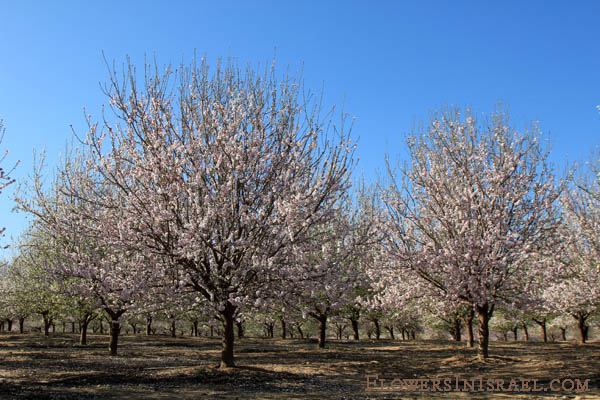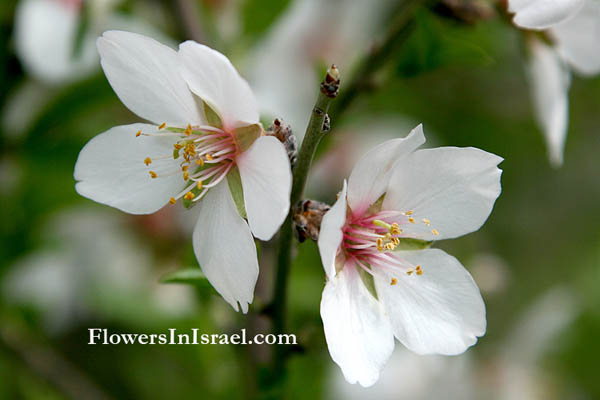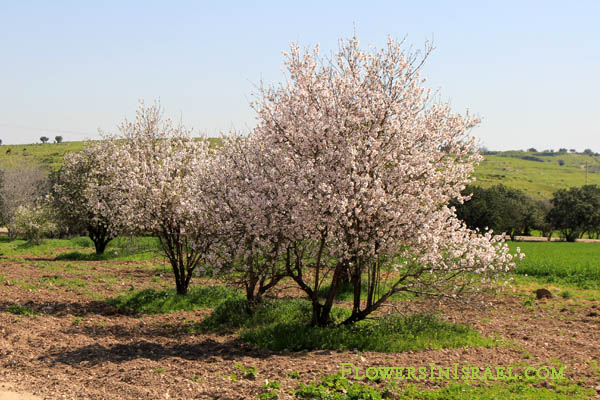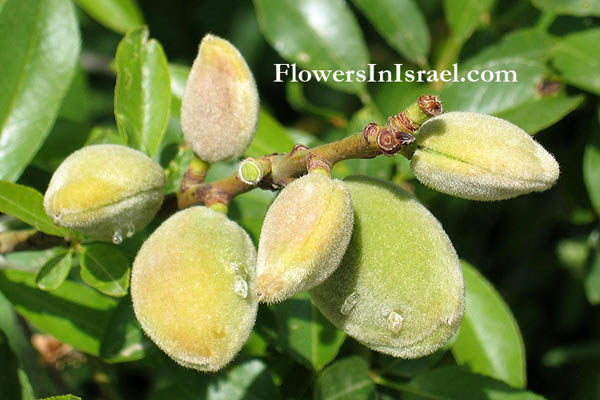Hebrew: שקד מצוי, Arabic: بادا
| Scientific name: | Amygdalus communis L. | |
| Synonym name: | Prunus dulcis(Mill.) D.A.Webb, Prunus amygdalus (L.) Batsch, | |
| Common name: | Common Almond | |
| Hebrew name: | שקד מצוי, Shaked Mazui | |
| Arabic name: | بادا | |
| Family: | Rosaceae, ורדיים |

|
| Life form: | Shrub or Tree | |
| Stems: | Greyish bark | |
| Leaves: | Alternate, entire, dentate or serrate | |
| Inflorescence: | Axillary buds produces in threes, flower before the leaves open | |
| Flowers: | Hermaphrodite only, sepals tomentose, petals c.20mm, bright pink in bud, fading to pale pink, or white | |
| Fruits / pods: | Ovoid-oblong fleshy drupe, grey-green tomentose skin, in which the pitted pericarp (hull) dries out at maturity splits along the central suture, and separates from the hard endocarp (shell). | |
| Flowering Period: | January, February, March | |
| Habitat: | Mediterranean maquis and forest | |
| Distribution: | Mediterranean Woodlands and Shrublands | |
| Chorotype: | Med - Irano-Turanian | |
| Summer shedding: | Perennating |

Derivation of the botanical name: Amygdalus, amygdala, αμυγδαλη, "an almond"; us, Latinizing suffix; almond like. communis, common. Prunus, Latin prūnus, Greek προῦνον prounon; plum tree. dulcis, sweet, pleasant. The Hebrew word: שקד, shaked, Aramaic: שקדא, skeda. Among the Hebrews, the almond tree was a symbol of watchfulness and promise due to its early flowering. It is referred to in the Bible as "Shaked", meaning "hasten", what explains the passage in Jer. 1:11-12: The word of the LORD came to me saying, "What do you see, Jeremiah?" And I said, "I see a rod of an almond tree." Then the LORD said to me, "You have seen well, for I am watching over My word to perform it." The Hebrew for watching sounds like the Hebrew for almond tree. The word "Luz", which occurs in Genesis 30:37, and that sometimes is translated as "hazel", is supposed to be another name for the almond. In Arabic the almond is called "Luz".
The Almond species that grow wild in Israel:
Almonds are mentioned six times in the Scriptures. The first reference is in Genesis 43:11 where Jacob, in an apparent attempt to become a favorite with the ruler of Egypt, orders his sons to bring them some of the "best products of the land" including almonds. The best-known reference to the almond is Aaron's rod that budded (Numbers 17:1-11). This is miracle because the flowering, budding, and fruiting of the almond in nature are always differ in time. The almond motif was part of the divine design for the lampstand in the tabernacle (Exodus 25:33-34, 37:19-20). Moses was instructed to make the bowls of the lampstand in the shape of the almond flower. The buds and fruits however,had also to be present. The reference to almonds in Ecclesiastes 12:5 could be because of the masses of white flowers on the almond tree, an allusion to the white hair of old age, or it could mean "despised." Christian symbolism uses the almond as a symbol of the Virgin's purity, from Numeri 17:1-11 (Aaron's Rod Buds). The almond-shaped aureole surrounding Christ or the Virgin is a Mandorla (Ital.'almond'), or 'vesica piscis'. The shape has no intrinsic significance and was varied in early Christian art. Originally the mandorla represented the cloud in which Jesus ascended. The mandorla first appears in 5th-century mosaics decorating the Church of Santa Maria Maggiore in Rome, where it surrounds certain Old Testament figures. By the 6th century the mandorla had become a standard attribute of Christ in scenes of the Transfiguration. Maria die Schale der Mandel, Christus der Kern. von dir quam der mandel kern durch die schalen ganz, als diu liebte sunne glänz durch daz unverwerte glas; Hoffm. Kl. 46, 3 sie ist die schal, Jesus der kern. See the list of Medicinal herbs in Israel, the parts used and their medical uses to treat various diseases. 
The 15th day of the month of Shvat marks the beginning of the "new year" for trees. Tu B'Shvat is the new year for the purpose of calculating the age of trees for tithing. The Torah states that fruit from trees which were grown in the land of Israel may not be eaten during the first three years; the fourth year's fruit is for God, and after that, the fruit can be eaten. Each tree is considered to have aged one year as of Tu B'Shvat, no matter when in the year it was planted. Almonds were given a prominent place in Tu B'Shvat, since the almond trees were believed to be the first of all trees in Israel to blossom, the “Shkedia,” the Almond Tree was the inspiration for the following Tu Bishvat song: השקדיה פורחת / מלים: י. דושמן לחן: מ. רבינא “Hashkediyah porachat” - “The almond tree blossoms” in celebration of Tu Bishvat, the New Year of the trees. השקדיה פורחת ושמש פז זורח. צפורים מראש כל גג מבשרות את בוא החג ט"ו בשבט הגיע חג לאילנות (פעמיים) Hashkediyah porachat V'shemesh paz zorachat; Tziporim m'rosh kol gag, M'vasrot et bo hechag. Tu Bish'vat higiya, chag ha'ilanot (2x) The almond tree is growing, A golden sun is glowing; Birds sing out in joyous glee From every roof and every tree. Tu Bish'vat is here, The Jewish Arbor Day Hail the trees' New Year, Happy holiday Bible resources:



|
